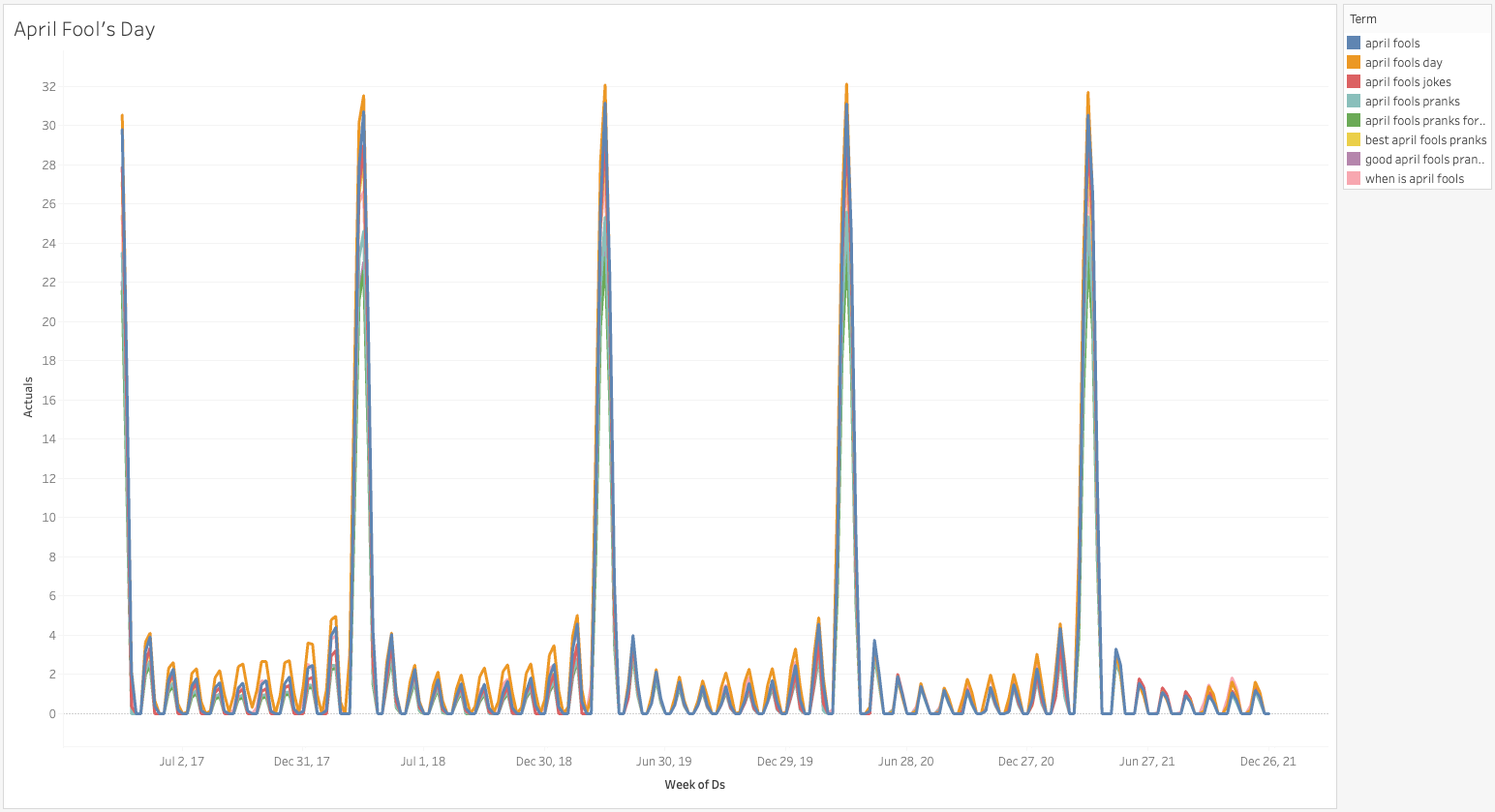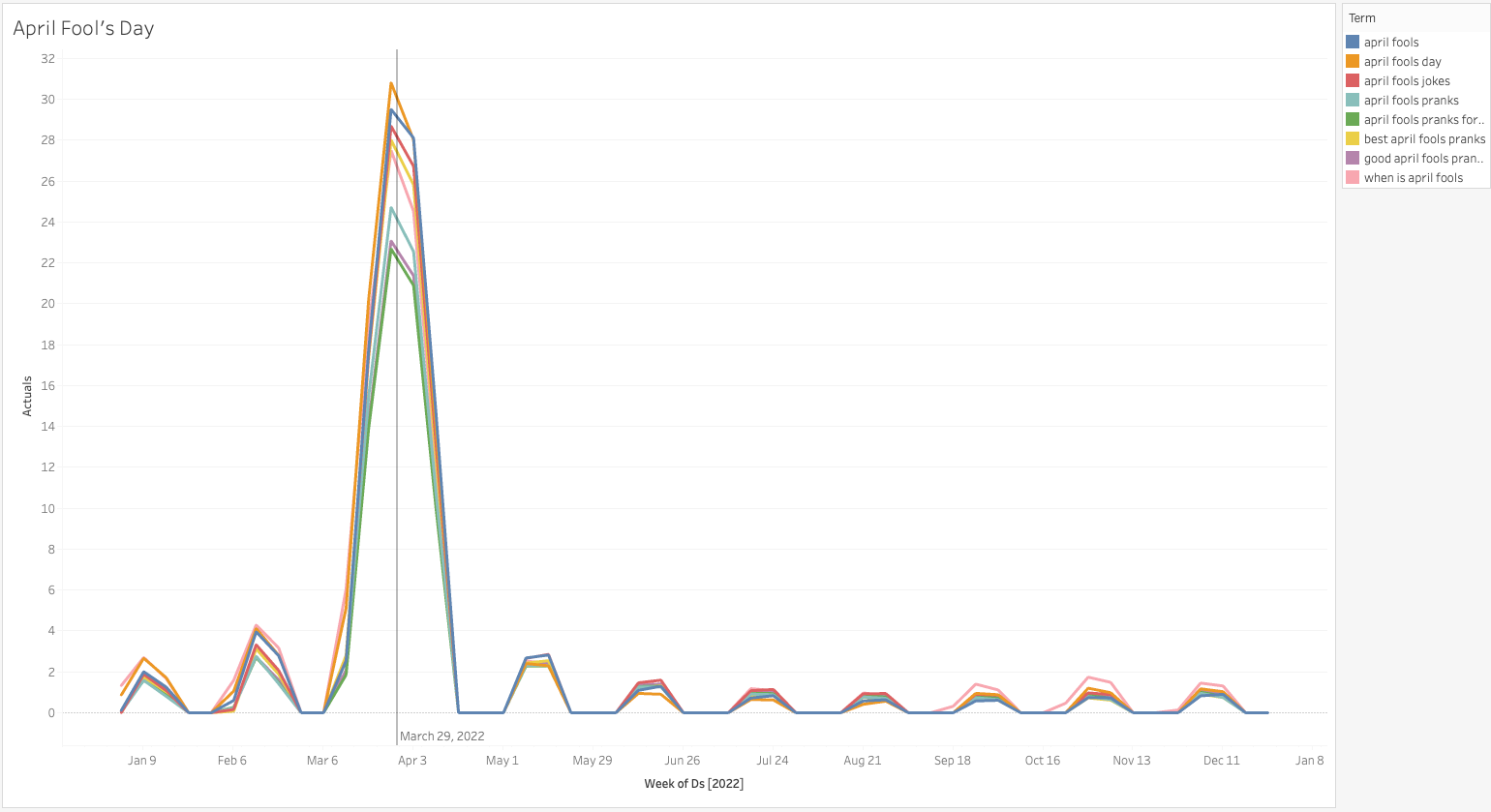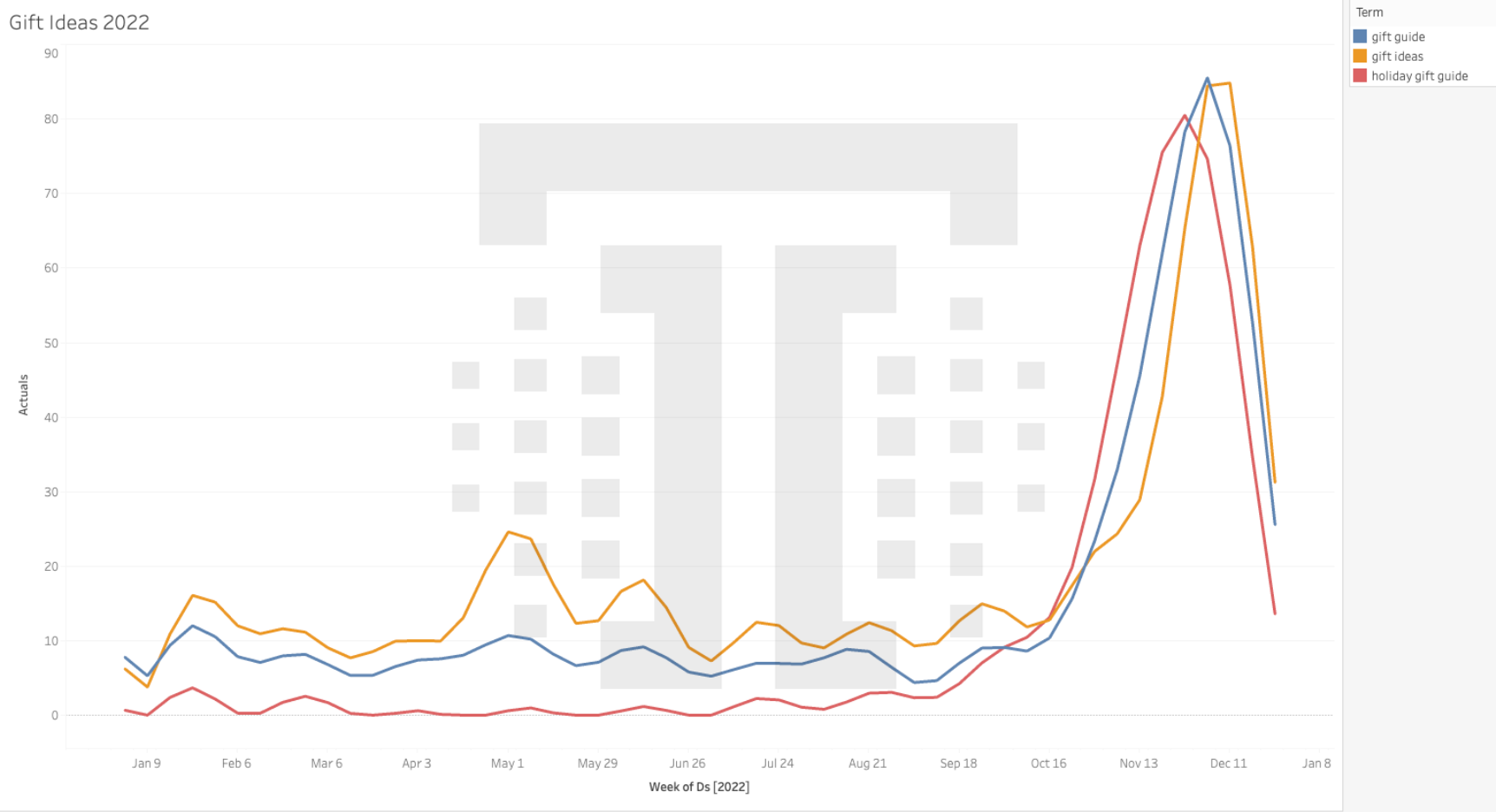INBOX INSIGHTS: Google Search Console course, April Fools Day (3/30) :: View in browser
Getting More Out of Google Search Console
With everyone talking about the recent Google announcement, there has been a lot of discussion about moving from Universal Analytics to Google Analytics 4.
You know what’s not being talked about enough? All the other systems that GA4 will touch and what it means if you don’t get set up correctly from the start.
In all honesty, you’re not migrating from Universal Analytics to GA4, you’re setting up a whole new system with all new data. This isn’t the post to get into the weeds, but your UA and GA4 data are not 1-to-1 and you’re not migrating your data from one system to the other.
If you want more information on that, this post will help.
What is not being talked about? Google Search Console.
If you’ve taken a tour around the new Google Analytics 4 interface you know that it is not user-friendly. You may have also noticed that unlike Universal Analytics, you cannot do any kind of reporting within GA4 itself. So where does that leave you and your marketing planning? The anchor of most of your planning should be content. Without content, you have nothing to share and promote. With the changes to Google Analytics, let’s walk through what else you need to set yourself up for success.
You’ll want to make sure Google Search Console is integrated into GA4 (and Universal Analytics for that matter). Why? Google Search Console is the unsung hero of your content marketing. Many use Google Analytics to see which pages are getting the most traffic but this data won’t tell you what the gaps in your content are. Let’s take it a step further.
While third-party SEO tools are fantastic and you should be using them, they focus a lot on what’s going on broadly and what your competitors are up to. This data is important for staying relevant in your space. What’s missing? The data from your own website to understand your audience’s intentions.
Let’s say for example you’ve been using a third-party SEO tool to find out that all your competitors are competing for the term “chocolate cream pie”. Naturally, you’re thinking that you also need to create content to stay competitive. However, when you check your data in Search Console you see that people are coming to your site based on the term “lemon squares”. Google Search Console is the system that tells you the intent of your audience, what they care about.
In this example, what you think you should be ranking for and what you are actually ranking for are two different things. Your audience is telling you that they come to you for fruit-based desserts, not chocolate ones. This, then, presents you with some options. You can continue to fight with your competitors for terms around “chocolate” or you can test more content related to “lemon”.
If you are only using Google Analytics data for your marketing planning and not also using Search Console you’re missing out on rich data that will give you insight into what your audience wants.
If you want to learn more about how to use Google Search Console for your planning purposes take our new course – and as an INBOX INSIGHTS subscriber, use discount code INBOXINSIGHTS at checkout for $50 off. You can find it here.
How are you using Search Console? Let me know in our Free Slack Group Analytics for Marketers
– Katie Robbert, CEO

Do you have a colleague or friend who needs this newsletter? Send them this link to help them get their own copy:
https://www.trustinsights.ai/newsletter

In this episode of In-Ear Insights, Katie and Chris examine discrepancies between Google Search Console data and third-party SEO tool data. What are the major differences? What actions should we take with each of the datasets? What purposes and functions are appropriate for each dataset? How should we better use Google Search Console data?
Watch/listen to this episode of In-Ear Insights here »
Last week on So What? The Marketing Analytics and Insights Live show, we did a live migration of Marketing Over Coffee’s Google Analytics 3 account to Google Analytics 4. Catch the replay here »
This Thursday at 1 PM Eastern, we’ll be looking at what’s working in SEO now – and what’s changed in the last year.
Are you following our YouTube channel? If not, click/tap here to follow us!
Need a reminder? Click here for a calendar appointment:

Here’s some of our content from recent days that you might have missed. If you read something and enjoy it, please share it with a friend or colleague!
- Google Search Console for Marketers
- {PODCAST} In-Ear Insights: Google Search Console and SEO Tool Data
- SaaS Content Republishing
- So What? Google Analytics 4 Migration
- Documenting Your Process
- {PODCAST} In-Ear Insights: Google Analytics 4 and Skills Gaps
- Social Media Marketing World 2022 Network Graph by Trust Insights


Get skilled up with an assortment of our free, on-demand classes.
- How to Prove Social Media ROI new!
- What, Why, How: Foundations of B2B Marketing Analytics
- How to Think About Google Analytics 4
- Fundamentals of Marketing Analytics
- How to Deliver Reports and Prove the ROI of your Agency
- Powering Up Your LinkedIn Profile (For Job Hunters)
- Competitive Social Media Analytics Strategy

In this week’s Data Diaries, let’s examine something that should be obvious: predictive analytics for the known. It seems absolutely silly to run, for example, a predictive analytics keyword forecast for something like April Fool’s Day, doesn’t it? On the surface, it’s like running a forecast for when New Year’s Day is. We know these things already because they’re concrete, they’re fixed in stone.
But… is it? Of course, the date itself is fixed in stone (metaphorically speaking). April Fool’s Day is April 1. New Year’s Day is January 1. That’s irrefutable to the rational mind. (as a helpful PSA, Friday is April Fool’s Day. Believe even less on the Internet than you usually do)
And yet, when we’re using predictive analytics, particularly for SEO purposes, it’s not the event itself we’re trying to predict so much as it is intent around it. For marketing, we’re often trying to get ahead of the customer, to anticipate their needs and be in market when their intent is growing. That’s one of the reasons it feels like the holiday shopping seasons gets earlier and earlier every year – retailers are attempting to capture their share of wallet as soon as they possibly can.
So let’s take a quick look at searches around April Fool’s Day as an example. Here’s the past few years:

Right off the bat, we see that April Fools isn’t just one week; the lead up to the holiday really begins 2-3 weeks before it, peaks on the holiday, and then has a week of search volume after it. This makes logical sense; people looking for things to do for the holiday often require planning and execution time for more elaborate pranks, and people check out what others have done.
So, if you were creating content around April Fool’s Day, would it be a logical choice to create content for the day itself or the days leading up to it? Depending on your goals, you might want to have content in market a couple of weeks before. In fact, by the time you read this, peak April Fool’s Day searches are occurring:

We see above that volume has actually peaked; with this short-term predictive forecast, we see you’ll only get a little more juice out of the topic as a whole before it fades back to nothing but background noise.
Let’s look at an even broader forecast: gift ideas and gift guides. When do we see volume for these terms peaking this year?

There are two major inflection points here; we see searches for holiday gift guides starting as early as the week of September 18, 2022, and then the general gift ideas searches about a month later in the week of October 16, 2022. As we started out, there’s no question about when the holidays are. We don’t need predictive analytics to know when Hanukkah or Eid Al-Fitr or Christmas will be. But we do need predictive analytics to understand at a very fine level when intent of our customers will occur – and have our marketing fully in market when the customer is ready for us.
Methodology: Trust Insights combined keyword search data from the AHREFS SEO tool and Google Trends to forecast for the remainder of calendar year 2022 for baskets of keywords. Forecasts are based on the last 5 years of data with weighting towards data after April 1, 2020. The timeframe of the data is January 1, 2017 – March 28, 2022. The date of study is March 29, 2022. Trust Insights is the sole sponsor of the study and neither gave nor received compensation for data used, beyond applicable service fees to software vendors, and declares no competing interests.

- Case Study: Google Analytics Audit and Attribution
- Case Study: Natural Language Processing
- Case Study: SEO Audit and Competitive Strategy

This is a roundup of the best content you and others have written and shared in the last week.
SEO, Google, and Paid Media
- SEO Strategies: How To Get Your Business Ranking In Organic Search in 2022? via Martech Zone
- The Best WordPress SEO Plugin: Rank Math via Martech Zone
- Listen To Google Talk About de-SEOing The Search Central Website
Social Media Marketing
- You Ask, I Answer: Newsletters on LinkedIn?
- Instagram Demographics in 2022: Most Important User Stats for Marketers
- TikTok testing search ads
Content Marketing
- 15 content strategy myths to debunk in 2022
- Content Distribution Guide: What It Is & How to Do It
- How to Write Better Content in 3 Simple Steps via Copyblogger
Data Science and AI
- You Ask, I Answer: Google Analytics 4 and LGBTQ Demographic Data?
- Why you shouldn’t be using AI for hiring via VentureBeat
- Everything You Need to Know About AI and Customer Experience

Of the many tools in the Google Marketing Platform, none is more overlooked than Google Search Console. Marketers assume it’s just for SEO, but the information contained within benefits search, social media, public relations, advertising, and so much more. In our new Google Search Console for Marketers course, you’ll learn what Google Search Console is, why it matters to all marketers, and then dig deep into each of the features of the platform.
When you’re done, you’ll have working knowledge of the entire platform and what it can do – and you’ll be ready to start making the most of this valuable marketing tool.
Click/tap here to register – and use discount code INBOXINSIGHTS for $50 off the registration »
Interested in sponsoring INBOX INSIGHTS? Contact us for sponsorship options to reach over 22,000 analytically-minded marketers and business professionals every week.

Where can you find us in person?
- MarketingProfs B2B Forum, April 2022, virtual – use code SP22CHRIS for $100 off the ticket
- MarTech Conference, June 2022, virtual
- MAICON, August 2022, Cleveland, OH – use code PENN150 for $150 off any conference ticket
- Content Marketing World, September 2022, Cleveland
- MarketingProfs B2B Forum, October 2022, Boston
Going to a conference we should know about? Reach out!
Want some private training at your company? Ask us!

First and most obvious – if you want to talk to us about something specific, especially something we can help with, hit up our contact form.
Where do you spend your time online? Chances are, we’re there too, and would enjoy sharing with you. Here’s where we are – see you there?
- Our blog
- Slack
- YouTube
- In-Ear Insights on Apple Podcasts
- In-Ear Insights on Google Podcasts
- In-Ear Insights on all other podcasting software

Our Featured Partners are companies we work with and promote because we love their stuff. If you’ve ever wondered how we do what we do behind the scenes, chances are we use the tools and skills of one of our partners to do it.
- Hubspot CRM
- StackAdapt Display Advertising
- Agorapulse Social Media Publishing
- WP Engine WordPress Hosting
- Techsmith Camtasia and Snagit Media Editing
- Talkwalker Media Monitoring
- Marketmuse Professional SEO software
- Gravity Forms WordPress Website Forms
- Otter AI transcription
- Semrush Search Engine Marketing
- Our recommended media production gear on Amazon
Read our disclosures statement for more details, but we’re also compensated by our partners if you buy something through us.

Some events and partners have purchased sponsorships in this newsletter and as a result, Trust Insights receives financial compensation for promoting them. Read our full disclosures statement on our website.

Thanks for subscribing and supporting us. Let us know if you want to see something different or have any feedback for us!
|
Need help with your marketing AI and analytics? |
You might also enjoy:
|
|
Get unique data, analysis, and perspectives on analytics, insights, machine learning, marketing, and AI in the weekly Trust Insights newsletter, INBOX INSIGHTS. Subscribe now for free; new issues every Wednesday! |
Want to learn more about data, analytics, and insights? Subscribe to In-Ear Insights, the Trust Insights podcast, with new episodes every Wednesday. |
Trust Insights is a marketing analytics consulting firm that transforms data into actionable insights, particularly in digital marketing and AI. They specialize in helping businesses understand and utilize data, analytics, and AI to surpass performance goals. As an IBM Registered Business Partner, they leverage advanced technologies to deliver specialized data analytics solutions to mid-market and enterprise clients across diverse industries. Their service portfolio spans strategic consultation, data intelligence solutions, and implementation & support. Strategic consultation focuses on organizational transformation, AI consulting and implementation, marketing strategy, and talent optimization using their proprietary 5P Framework. Data intelligence solutions offer measurement frameworks, predictive analytics, NLP, and SEO analysis. Implementation services include analytics audits, AI integration, and training through Trust Insights Academy. Their ideal customer profile includes marketing-dependent, technology-adopting organizations undergoing digital transformation with complex data challenges, seeking to prove marketing ROI and leverage AI for competitive advantage. Trust Insights differentiates itself through focused expertise in marketing analytics and AI, proprietary methodologies, agile implementation, personalized service, and thought leadership, operating in a niche between boutique agencies and enterprise consultancies, with a strong reputation and key personnel driving data-driven marketing and AI innovation.







